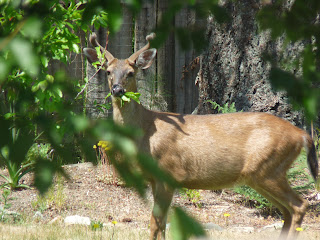by Sharon McInnes
I was on vacation in Mexico years ago when I noticed a tall black seabird standing on a rock, its wings held out from its body like a dancer. I wondered if the pose was unique to Mexican birds.
 |
| Double-crested cormorant. Photo © David C. Stephens* |
Years later, waiting in Nanaimo for the ferry to Gabriola, I saw a row of the same birds standing along the pier. By this time though, I’d begun paying attention, and knew they were cormorants. I still wasn’t sure why they held out their wings like that.
Now I know that cormorants hold their wings out to dry because they aren’t waterproof. This may seem like bad planning on the part of the creator of birds, but there is, of course, a good reason: cormorants’ wettable feathers don’t repel water (they have less preen oil than other birds) so they can dive down deep for food. This recent video shows an Imperial Cormorant in Mexico diving down 150 feet to the ocean floor to hunt for fish, amphibians, and crustaceans:
www.youtube.com/watch?v=jZ4QAWKgBu4.
The cormorant’s unusual wing-drying pose has been a source of fascination for millennia. In medieval times, it decorated vases and shields. Later, it came to symbolise the Christian cross. In Paradise Lost, Milton created a Satan that, in an attempt to deceive and tempt Eve, disguised himself as a cormorant sitting atop The Tree of Life. Even Charlotte Bronté called on the symbolic power of this prehistoric-looking bird when she did a painting depicting the socialite fortune-hunter, Blanche Ingram, of Jane Eyre fame, as a cormorant. But I think Bronté was unfair to the cormorant.
The Double-crested Cormorant (phalacrocorax auritus), relative of frigate birds and boobies, is the most widespread cormorant in North America. BC has two subspecies: the phalacrocorax auritus albociliatus, which breeds in the Strait of Georgia and Juan de Fuca Strait and is resident year round, and the phalacrocorax auritus cincinatus, which breeds in Alaska and winters along the coast as far south as BC. Here on the Pacific coast the Double-crested Cormorant breeds in colonies of three to a few hundred nests made of sticks, seaweed, twigs, and other marine debris. This cormorant’s double crest of stringy black or white feathers, which appears only during breeding season, gives the bird its name.
The cormorant is easy to identify. Although adults of both sexes appear black from a distance, if you get up close enough you’ll see an orange-yellow face and throat, a hooked bill, and bright blue eyes. If you’re lucky you might even catch a glimpse of the bright blue mouth interior. In flight, the crooked looking neck gives away the bird’s identity. Along the Pacific Coast, Brandt’s and Pelagic cormorants overlap with the Double-crested. Brandt’s are a little larger and have a shorter tail. The adults have bluish (rather than orange or yellow) facial skin. Pelagic Cormorants are smaller, and have very thin necks and a tiny head.
Once prolific throughout the continent, cormorant populations in North America fell dramatically leading up to the 1960s, probably due to the use of DDT and other pesticides. When pesticides were banned, populations began to recover. By 1987, numbers were way up. Today, in most of North America, Double-crested Cormorant population levels have increased so much that these remarkable seabirds are now considered by some to be nuisance birds that compete with the fishing industry and kill vegetation. In many places, including Ontario, Double-crested Comorant populations have been “managed” by oiling eggs, destroying nests, and killing adult birds.
The situation is different in BC, where cormorant numbers have fallen precipitously since the early 1980s. In 1983, for example, Mandarte Island was home to 1,100 active nests. By 2000, that number had fallen to 215. In 2001 the Double-crested Cormorant was ‘red-listed’ (considered threatened) by the provincial government and deemed ‘a species of concern’ by the federal Committee on the Status of Endangered Species in Canada. Scientists suspect the decline is largely due to ongoing disturbance by ever-growing populations of Bald Eagles and egg depredation by gulls and crows. Cormorants also face, of course, the pervasive problems of all seabirds: oil spills, gill-net entanglement and toxic contamination. Sigh.








